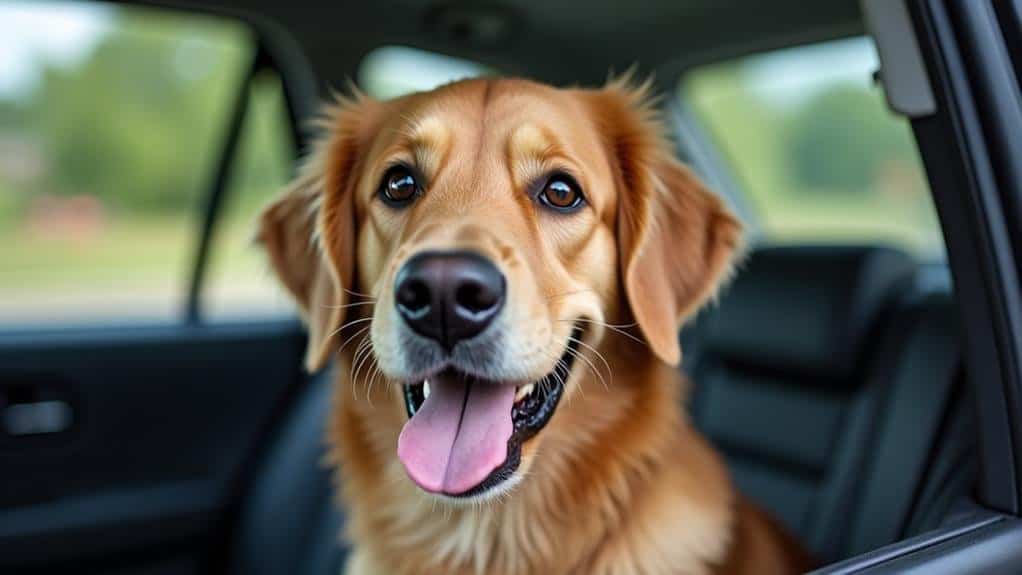Dogs often pant in cars due to anxiety, overheating, or excitement. Your furry friend might be stressed from past negative experiences, motion sickness, or discomfort from restraints. Signs of travel anxiety include excessive drooling, restlessness, and attempts to escape. To help your dog, gradually acclimate them to car rides, guarantee proper ventilation, and offer water breaks. Create a comfortable space with familiar items and plan frequent stops. Sometimes, excessive panting can indicate underlying health issues, especially in older dogs. By understanding these factors, you'll be better equipped to make car rides more enjoyable for your canine companion.
Common Causes of Car Panting

When it comes to understanding why your dog pants excessively during car rides, several factors come into play. The primary reason for dog panting is to regulate their body temperature. Unlike humans, dogs have limited sweat glands, so they rely on panting to cool down.
However, excessive panting can signal underlying issues beyond temperature control. Anxiety is a common culprit for excessive panting during car rides. Your dog may associate the vehicle with negative experiences or feel stressed in confined spaces. This anxiety can manifest as rapid breathing and restlessness.
Motion sickness is another frequent cause, especially in younger or nervous dogs. The disorienting sensation of movement can trigger nausea and panting. Overheating is a serious concern, particularly if you're traveling in hot weather. A car's interior can quickly become dangerously warm, intensifying your dog's panting as they struggle to cool down.
Additionally, discomfort from tight restraints or inability to move freely can lead to stress-induced panting. It's vital to guarantee your dog's comfort and monitor their behavior during car rides. If excessive panting persists, it may indicate a more serious health issue requiring veterinary attention.
Signs of Canine Travel Anxiety
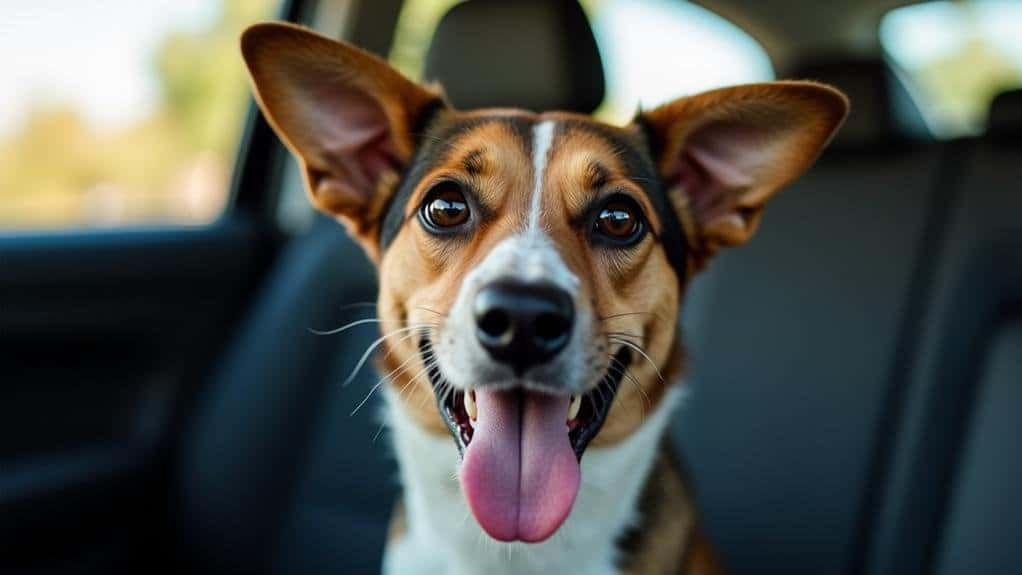
Recognizing the signs of canine travel anxiety is key to addressing your dog's discomfort during car rides. When traveling with your furry friend, you'll want to watch for excessive panting, drooling, and restlessness, as these are common indicators of stress.
You might notice your dog pacing, whining, or even attempting to escape the vehicle, signaling their discomfort with the situation. If your dog trembles or tries to hide near the car, it could be a sign of fear or anxiety, especially if they've had negative experiences with travel in the past.
Pay attention to subtle signs of discomfort, such as yawning or lip licking, which often accompany panting during stressful journeys. These behaviors can be your dog's way of communicating their unease.
Changes in your dog's behavior, like reluctance to enter the car or increased fidgeting, should also raise a red flag. By being attentive to these signs, you can better understand your dog's anxiety and take steps to make car rides more comfortable for them.
Temperature Regulation During Rides
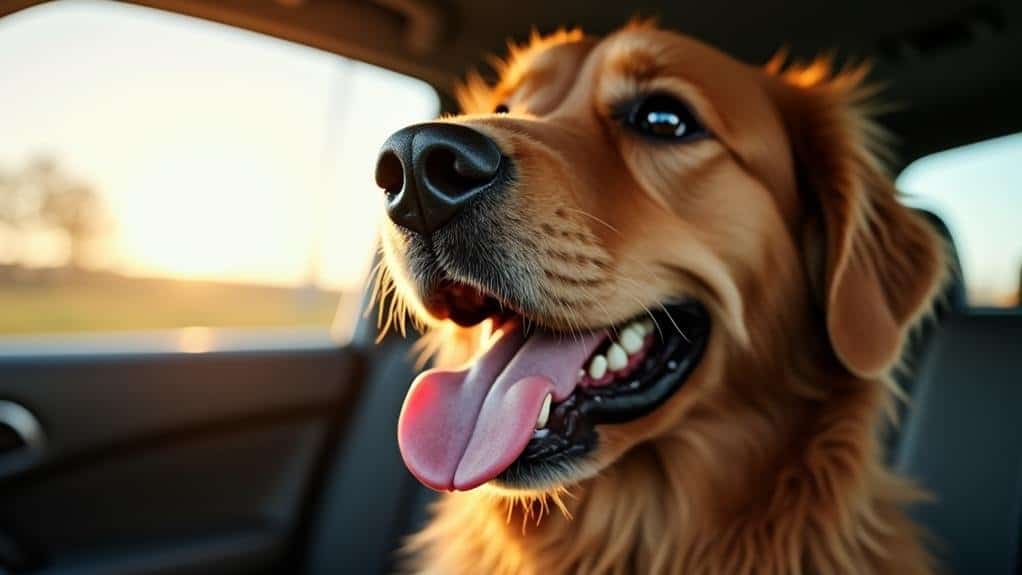
Temperature regulation is an essential aspect of ensuring your dog's comfort during car rides. Your furry friend primarily relies on panting to cool down, as they've limited sweat glands. In a hot car, the temperature can quickly rise to dangerous levels, putting your dog at risk of heat exhaustion. To prevent this, you'll need to actively manage the environment inside your vehicle.
During car journeys, your dog's panting may increase due to a combination of excitement and heat. This is their way of trying to regulate their body temperature. To help them stay comfortable, provide adequate ventilation by rolling down windows or using air conditioning. This will help maintain a comfortable temperature and allow fresh air to circulate.
On long car journeys, it's important to offer your dog regular water breaks. Panting can lead to dehydration, so keeping them hydrated is essential for their well-being.
Stress Management for Dogs
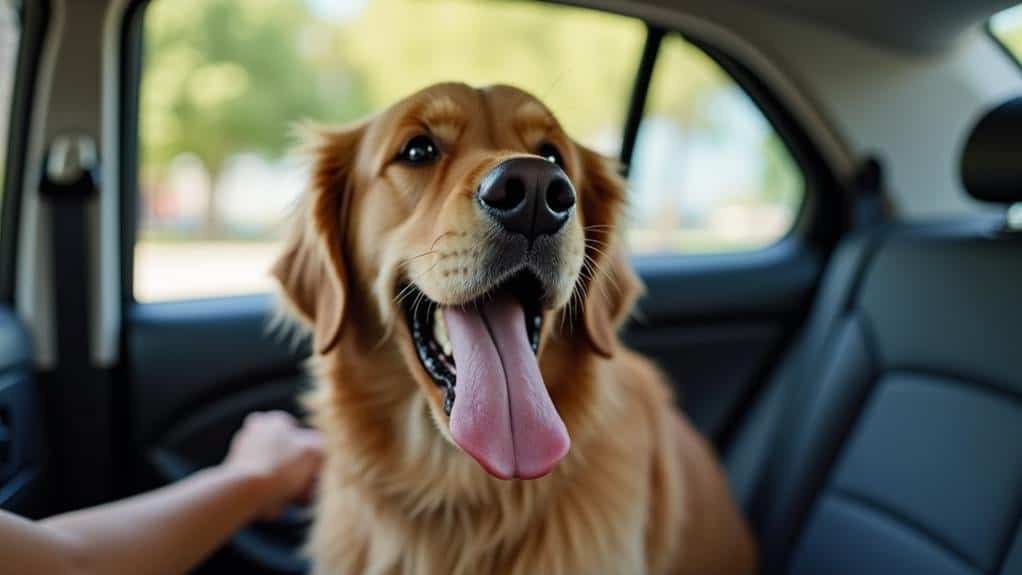
Managing your dog's stress during car rides is just as important as regulating temperature. Dogs pant excessively in cars due to anxiety, but you can alleviate this through various strategies. Start by gradually acclimating your dog to the vehicle, creating positive associations with short trips and rewards.
Implement training techniques that reinforce calm behavior with treats and praise, helping your furry friend feel more at ease during travel.
To further reduce car anxiety, consider using calming products like Thundershirts or natural pheromone sprays. These can noticeably lower stress levels in stressful situations.
Establish a consistent routine for car travel, including:
- Regular hydration breaks
- Planned stops for stretching and bathroom needs
- Familiar comfort items like a favorite toy or blanket
- A designated spot in the vehicle for your dog
Monitoring for signs of distress is essential in managing anxiety effectively. Watch for excessive panting, pacing, or drooling, and be prepared to intervene if necessary.
Preventive Measures for Car Comfort
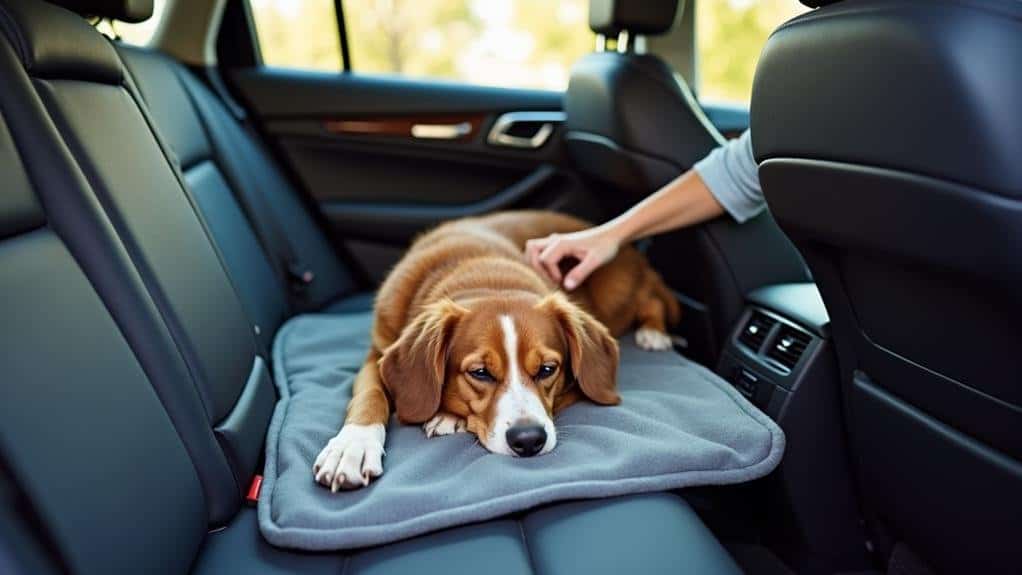
Your dog's comfort during car rides begins long before you hit the road. To combat car anxiety and excessive panting, start by gradually acclimating your furry friend to car travel. Take short trips to build positive associations, reducing stress during longer journeys.
Temperature regulation is essential for your dog's well-being. Create a cool environment by using portable fans or air conditioning to prevent overheating, which can lead to excessive panting. Hydration plays an important role in your dog's comfort, so offer fresh water before the trip and during rest stops.
Establish a secure and familiar space in the car using your dog's favorite blanket or toys. This creates a comforting environment that can help alleviate stress and promote relaxation during the journey.
Plan for frequent rest stops every two hours to provide stress relief and comfort. These breaks allow your dog to stretch, relieve themselves, and take a breather from the confined space.
Addressing Underlying Health Issues
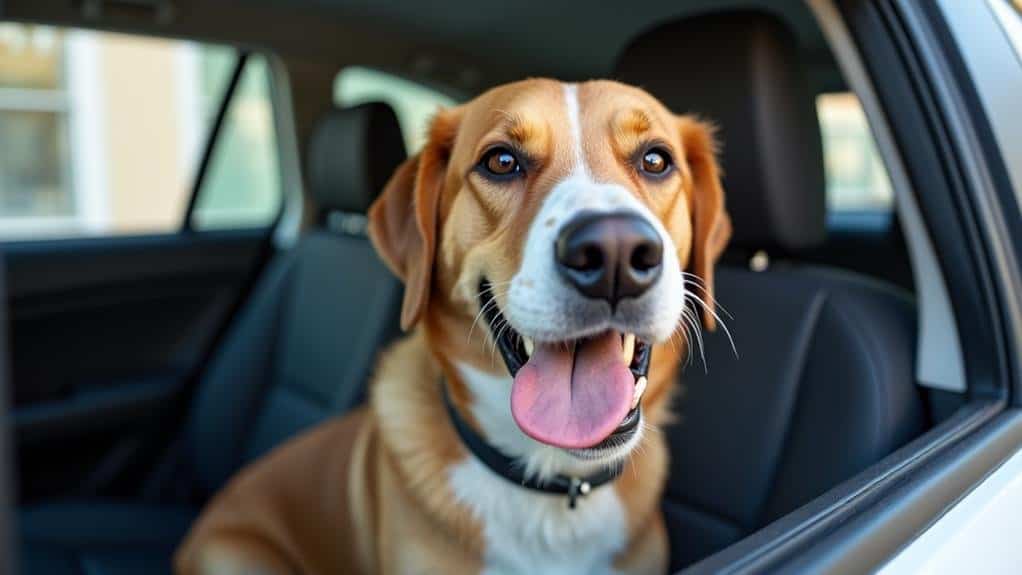
While preventive measures can greatly enhance your dog's car experience, it's important to take into account that excessive panting might signal underlying health issues.
If your dog is panting more than normal during car rides, it could indicate serious conditions such as heart disease or respiratory problems. Don't ignore these signs, as they may require immediate veterinary care.
It's vital to distinguish between normal and abnormal panting behaviors. Persistent panting without evident triggers, like heat or exercise, may suggest conditions such as Cushing's disease or chronic pain.
Older dogs are particularly susceptible to these issues. If your dog appears anxious or stressed during car rides, it could be exacerbating pre-existing health problems.
To help your dog and address potential underlying health concerns:
- Monitor panting patterns and note any changes
- Look for additional symptoms like lethargy or reluctance to move
- Schedule regular veterinary check-ups for early detection
- Consult your vet if you suspect breathing difficulties
Frequently Asked Questions
How Do I Stop My Dog Panting Anxiety When Car Trips?
To reduce your dog's panting anxiety during car trips, you'll want to start with short rides and gradually increase duration. Use calming tools, guarantee proper ventilation, and bring familiar items. If issues persist, consult your vet for additional strategies.
Why Does My Dog Pant Constantly in the Car?
Your dog's constant panting in the car could be due to temperature regulation, anxiety, motion sickness, or excitement. It's their way of cooling down and coping with stress. Monitor for other signs of distress and consult your vet if concerned.
How Do I Get Rid of My Dogs Anxiety in the Car?
You'll want to gradually acclimate your dog to car rides. Start with short trips, use calming aids, and bring familiar items. Keep the car cool and comfortable. If anxiety persists, consult your vet for behavioral therapies or medications.
Does Dog Panting Mean Anxiety?
Dog panting can indicate anxiety, but it's not always the case. You'll need to look for other signs like restlessness or drooling. Panting can also mean your dog's hot, excited, or just finished exercising. Context is key.
Conclusion
You've learned why your dog pants in the car and how to address their anxiety. Remember, it's not just about the journey; it's about your pup's comfort and well-being. By recognizing signs of stress, managing temperature, and addressing underlying issues, you'll make car rides more enjoyable for your furry friend. With patience and the right approach, you can turn those stressful trips into positive experiences for both you and your canine companion.

